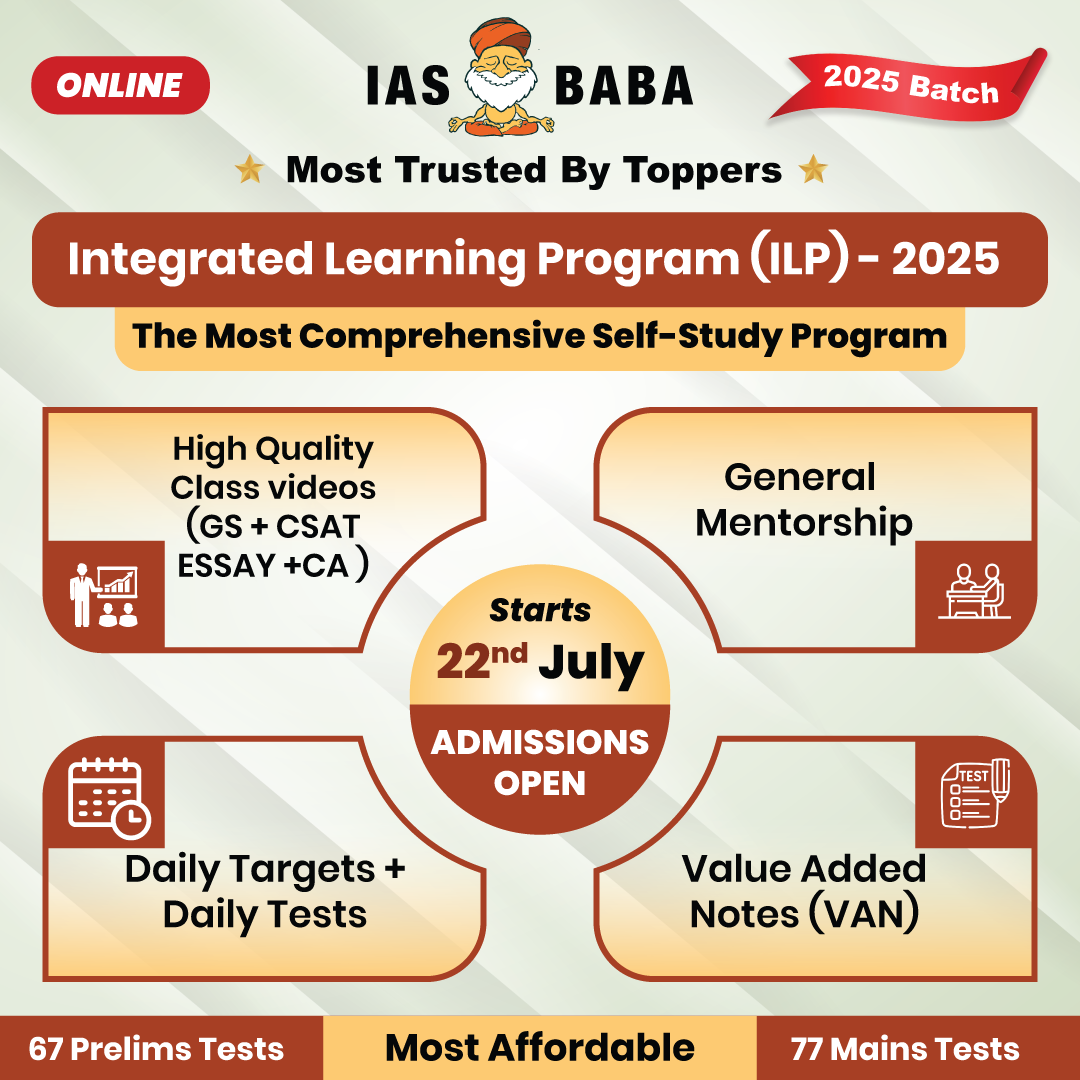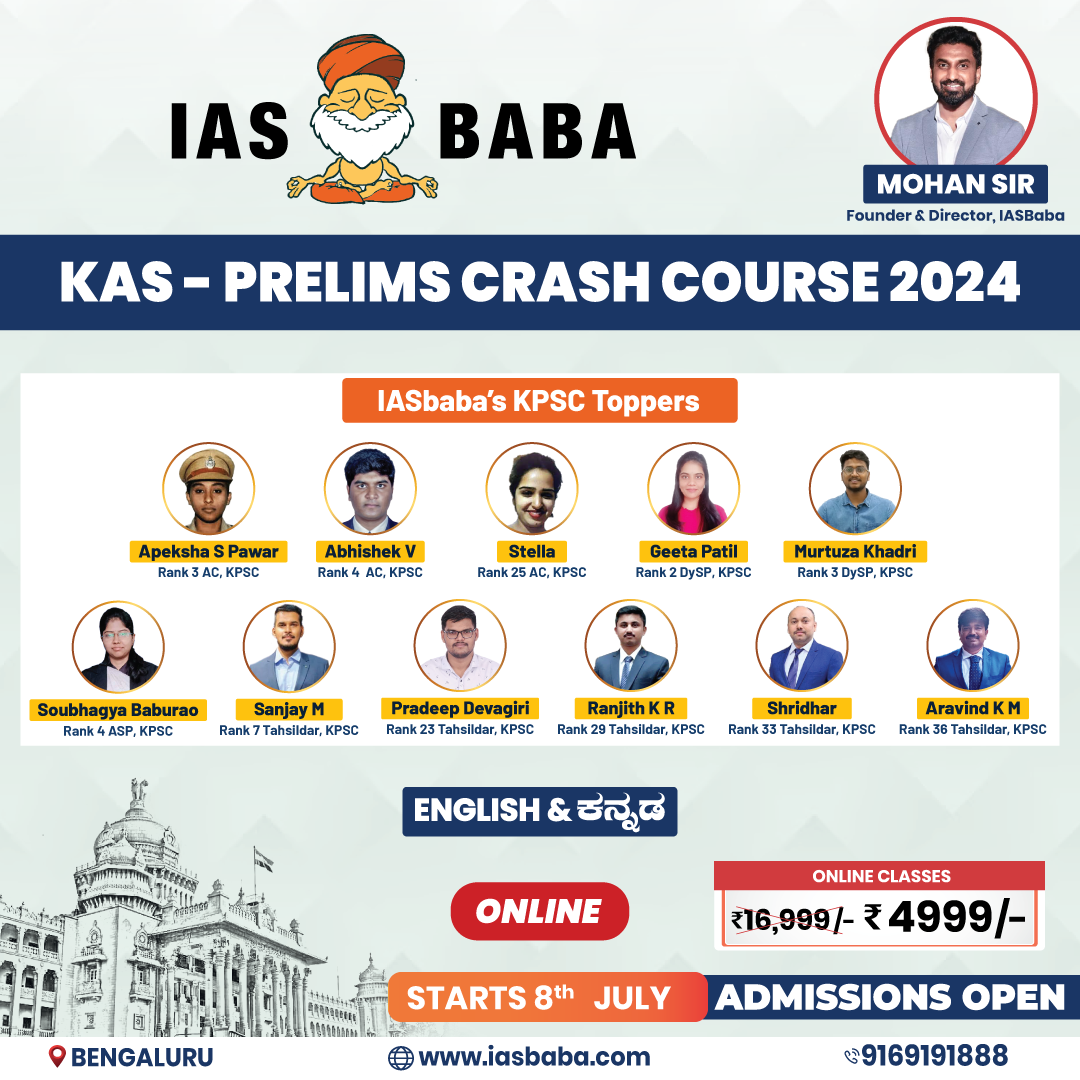IASbaba's Daily Current Affairs Analysis
IAS UPSC Prelims and Mains Exam – 31st January 2019
Archives
(PRELIMS + MAINS FOCUS)
Centre hikes scholarships
Part of: GS Mains II and III – Government schemes and programmes; Science and Technology; Research and Development
In news:
- Centre hiked the research scholarship
- Junior Research Fellowship – scholarship hiked to ₹31,000 per month from the existing ₹25,000.
- Senior Research Fellowships (SRF) – scholarship hiked to ₹35,000 per month
- Stipends for Research Assistants would range from ₹47,000 to ₹54,000 per month.
- For months, research scholars across India have organised protests demanding that the scholarship be hiked as the stipend hadn’t been revised since 2014.
- The hikes were recommended based on inflation.
However, in percentage terms, this is the lowest hike since 2010.
In spite of being a leading scientific power in terms of research publications, India spends only about 0.7% of its GDP on research and development, which is much lower than countries of comparable scientific prowess.

Study says cow urine may be adding to global warming
Part of: GS Prelims and Mains III – Environment and Ecology; Pollution; Global Warming
In news:
As per study conducted by in Colombia, Argentina, Brazil, Nicaragua, Trinidad and Tobago –
- Cow urine may also contribute to global warming
- The urine from the ruminant is a source of nitrous oxide emissions (N2O), a gas that is 300 times more powerful than carbon dioxide.
- That cattle and livestock are a significant source of methane, a greenhouse gas, and therefore a contributor to global warming, is well-known. However, the role of cow urine is less understood.
- Degraded pastures emitted significantly more N2O — sometimes up to three times as much.

Pic: https://d39gegkjaqduz9.cloudfront.net/TH/2019/01/31/DEL/Delhi/TH/5_07/49fe98e7_2700835_101_mr.jpg
Do you know?
- Dung and urine are commonly mixed together for manure in Indian fields.
- Since, India also hosts the world’s largest livestock population, as well as significant tracts of degraded land, the findings may have a bearing on nitrogen emissions from Indian fields.
- As per 2012 ISRO satellite study, 30% of India’s geographical area is degraded.
- Degraded grasslands emitted more N2O than healthy pastures because the vegetation in the latter took up some of the reactive nitrogen compounds and only the leftovers were emitted.
Revamped Khelo India Scheme
Part of: GS Prelims and Mains II– Government schemes and programmes; Human Development
Key pointers:
- Under Khelo India Scheme, 1,000 selected athletes will receive an annual scholarship of Rs 500,000 each for eight years.
- The scheme, which would cost the government Rs 1,756 crore between 2017-18 and 2019-20, will also promote 20 universities across India as hubs of sporting excellence.
- The revamped Khelo India programme would impact the entire sports ecosystem, including infrastructure, community sports, talent identification, coaching for excellence, competition structure and sports economy.
- Until now, sports schemes were focused on building infrastructure such as stadiums. However, the new scheme will focus on nurturing talent and connecting rural India to global games.
- Companies could also fund the Khelo India scheme under corporate social responsibility.
India-Russia ties
Part of: GS Prelims and Mains II – India and the world; International Relations
In news:
- Russian envoy said the $5.2-billion deal for the S-400 missile defence system, (despite pressure from the U.S. and threats of sanctions), is a proof of the special nature of the partnership between the two countries.
- The S-400 is a highly advanced surface-to-air missile defence system that can shoot down hostile jets and missiles.
- Kudankulam nuclear power plant in Tamil Nadu was being developed successfully (with assistance from Russia).
DIPP rechristened to include internal trade
Part of: GS Prelims and Mains III – Indian Economy and related issues
In news:
- The government has notified changing the name of the Department of Industrial Policy & Promotion (DIPP) to the Department for Promotion of Industry and Internal Trade, and has enhanced its role.
Four new categories of responsibilities –
- The renamed body will be in charge of promotion of internal trade (including retail trade),
- The welfare of traders and their employees,
- Matters relating to facilitating Ease of Doing Business, and
- Matters relating to start-ups.
Do you know?
Department of Industrial Policy and Promotion is also responsible for Intellectual Property Rights relating to Patents, Designs, Trade Marks, Geographical Indication of Goods, Copyrights and Semiconductor Integrated Circuits Layout Design and oversees the initiative relating to their promotion and protection.
Miscellaneous:
1. ‘Project Gaushala’
In news:
- Madhya Pradesh government to set up 1,000 ‘gaushalas’ or cow shelters in the State in the next four months to accommodate around one lakh stray cows and their progeny.
- Setting up ‘gaushalas’ in every village panchayat was a key promise made by the Congress in its manifesto for the 2018 Assembly elections.
- With this announcement, the government expects to not only tackle stray cattle menace but also create 40 lakh man-days employment.
- The Department of Rural Development will be the project’s nodal agency. The project will be implemented by gram panchayats, self-help groups, the institutions empanelled with the State Board for Conservation of Bovine Animals etc.
2. ISRO launched Human Space Flight Centre
In news:
- The Human Space Flight Centre, which will be the hub of ISRO’s manned missions, was inaugurated at the ISRO headquarters in Bengaluru.
- Gaganyaan, the country’s first crewed mission, is set to happen by 2022.
(MAINS FOCUS)
INTERNATIONAL
TOPIC: General studies 2
- India and its neighbourhood
- Effect of policies and politics of developed and developing countries on India’s interests
India to face difficult external situation in 2019
As India enters 2019, the world outlook looks gloomy.
Global Outlook:
- Global disorder is on the rise: A global leadership vacuum is leading to chaos concerning rules governing the international order.
- Beginning of a new Cold War:S. President Donald Trump’s utterances and actions are provoking strong counter-reactions, especially from China and Russia. (U.S. Vice President Mike Pence’s attack on China; Trump has threatened to pull out of a major arms control treaty with Russia)
- Rising political tensions, trade wars and protectionism are indications of the world processes that threaten to destroy globalization.
- A decline in Britain’s financial assets and of the pound sterling following Brexit, as well as signs of increasing fragility of China’s economy, are newer concerns.
Asian Outlook:
1. Rise of Russia:
- Russia is vigorously pursuing its pivot to Asia and for greater influence in Eurasia. It has deepened its partnership with China, and enhanced relations with Japan and South Korea.
- Growing tensions in the Sea of Azov (following Russia’s seizure of Ukraine’s ships) could well lead to a major conflagration between Russia and the West.
2. China’s rising outreach:
- China is consolidating its position in Asia. In addition to its strategic partnership with Russia, China has mended fences with Japan.
- The strengthening of the Russia-China strategic relationship and the recent warmth in China-Japan relations could impact India’s relations with both countries.
- Its Belt and Road Initiative has become the most potent weapon in China’s armoury, with Vietnam and Japan endorsing this concept.
- In 2018, China had initiated certain moves to create a China-Myanmar Economic Corridor on the lines of the China-Pakistan Economic Corridor (CPEC).
- The Chinese Navy is also poised to challenge India’s position in the Indian Ocean. Chinese submarines already outnumber India’s here.
- China is preparing to seek control f the Kyaukpyu Port on the Arakan Coast in Myanmar, and planning a canal (the Kra canal), connecting the Andaman Sea with the Gulf of Thailand.
- China has already control over the Gwadar (Pakistan) and Hambantota (Sri Lanka) Ports.
- 2019 could see a further consolidation of the ‘all weather friendship’ of China-Pakistan. (Pakistan facilitated China’s involvement in Afghanistan; CPEC etc)
3. The prospects of India-Pakistan relations improving look extremely bleak
- Cross-border terror attacks are likely to continue
- Sponsorship of terror groups like the Lashkar-e-Taiba and the Jaish-e-Mohammed
- India has been kept out of talks with the Afghan Taliban
4. The outlook for India in the rest of South Asia is also mixed
- Towards the end of 2018, India retrieved its position in the Maldives.
- India also succeeded in re-establishing its influence in Bhutan.
- The return of Sheikh Hasina as Prime Minister after the general elections in Bangladesh has been a welcome relief.
The way ahead:
India cannot hope to remain insulated from the above trends.
- India will need to work harder in 2019 to check China from weaning away its neighbours, including Nepal as also Bangladesh, with offers of economic and military aid.
- India will also need to use all its resources to assist Bangladesh to limit the influence of radical Islamist groups there.
- India will need to use up a great deal of its diplomatic capital to ensure that relations with Russia and Japan do not decline to any considerable extent. At same time, managing relations with China should be India’s top priority.
- On the diplomatic front, India will need to be more dexterous.
Connecting the dots:
- India needs to drive an independent foreign policy with its neighbours and Asian countries, rather than being massively influenced by China’s activities in the region. Discuss.
WELFARE/ECONOMY
TOPIC:
General studies 3
- Issues related to direct and indirect farm subsidies and minimum support prices
- Inclusive growth and issues arising from it.
General Studies 2
- Government policies and interventions for development in various sectors and issues arising out of their design and implementation.
- Welfare schemes for vulnerable sections of the population by the Centre and States and the performance of these schemes; mechanisms, laws, institutions and bodies constituted for the protection and betterment of these vulnerable sections
Why a simple universal basic income will not solve the fundamental problems of the economy?
Introduction:
- In previous day’s editorial analysis we read about – Why Guaranteed basic income is not a solution to mass poverty?
- Today’s editorial deals with why a simplistic universal basic income will not solve the fundamental problems of the economy?
Key pointers:
- We know that India’s GDP is growing quite well. Despite its achievements on economic front, India failed to do much better to improve overall human development. (Its performance is poorer compared with countries in Sub-Saharan Africa)
- Even its poorer sub-continental neighbours are improving health and education faster.
- Benefits of India’s economic growth must trickle down much faster to people at the bottom of the pyramid. (Poor farmers, landless rural labour, and hundreds of millions of workers living on the edge in low-paying, ‘flexible’ forms of employment with no social security)
Economists are offering universal basic income (UBI) as a solution to the economy’s structural problems.
However, even these economists admit that a lot more must be done to improve education and health care, and to address the persistent informality and small scale of enterprises that are providing most of the employment in the country.
Disruption and basic income
- Structural forces within the global economy have been driving down wages and creating insecure employment.
- There has been increasing economic inequalities around the world.
- ‘Industry 4.0’, which has not yet spread too far, is expected to worsen these problems.
- Declining global wage income growth means reduction of consumption and there is no guarantee of success of automated Industry 4.0 production systems. (Who will buy all the material and services that these systems will produce?)
Therefore, the UBI has appeared as a silver bullet solution. It will be an income provided to everybody by the very state.
The beauty of a ‘universal’ basic income is that it avoids messy political questions about who deserves assistance.
It also side-steps the challenge of actually providing the services required: education, health, food, etc. Just give the people cash: let them buy what they need.
Therefore, the concern lies here.
Concerns:
- Providing cash alone will not provide citizens with good quality and affordable education and health, because neither the government nor the private sector is able or willing to, this will not solve the basic human development problems that must be solved.
- India’s proposed UBI is diluted form. Economists have diluted their simplistic concept of UBI to make it financially and politically feasible.
- They propose a QUBRI (quasi-universal basic rural income), targeted only at poorer people in the rural areas. Their scheme is no longer universal.
As we discussed in previous day’s editorial analysis –
- The proposed UBI fails to identify who to identify the poor to be included.
- It will not cover the masses of urban poor working for low and uncertain wages (as it is targeted only at poorer people in the rural areas).
- Also it is proposed to offer income support by cutting back other schemes which can have other consequences.
However, this still begs the question about how to provide good quality public services for people to buy.
Therefore, a simplistic UBI will not solve the fundamental problems of the economy.
Need of the hour:
- Fix India’s fundamental problems by strengthening of institutions of the state to deliver the services the state must (public safety, justice, and basic education and health)
- Services provided by the state should be available to all citizens regardless of their ability to pay for them. (Inclusive services)
- The institutions of the state should also regulate delivery of services by the private sector and ensure fair competition in the market.
- The building of state institutions, to deliver and to regulate, will require stronger management, administrative, and political capabilities, not just better economists.
- Reduce inequality – opportunities for progress should be made equal and accessible to create a more just society.
Concept of Universal Basic Capital
- A better solution to structural inequality than UBI is universal basic capital, or UBC, which has begun to pop up in international policy circles.
- In this alternative approach, people own the wealth they generate as shareholders of their collective enterprises. Amul, SEWA, Grameen, and others have shown a way.
- Some economists go further and also propose a ‘dividend’ for all citizens, by providing them a share of initial public offerings on the stock market, especially from companies that use ‘public assets’, such as publicly funded research, or environmental resources.
Conclusion/Crux
To conclude, three better solutions to create more equitable growth than the ones on offer are:
- Focus on building state capacity beginning with implementation of the recommendations of the Second Administrative Reforms Commission.
- Strengthen the state institutions and missing middle-level institutions for aggregation of tiny enterprises and representation of workers.
- Creativity of economists could be better applied to developing ideas for UBC than UBI.
Connecting the dots:
- Serious consideration must be given to the idea of a universal basic income as a more effective way to address mass poverty concern. Comment.
- The idea of a Universal Basic Capital instead of Universal Basic Income is gaining traction across the world. Do you think UBC will be a better solution to structural inequality and more effective than UBI? Discuss.
(TEST YOUR KNOWLEDGE)
Model questions: (You can now post your answers in comment section)
Note:
- Featured Comments and comments Up-voted by IASbaba are the “correct answers”.
- IASbaba App users – Team IASbaba will provide correct answers in comment section. Kindly refer to it and update your answers.
Q.1) The government has relaunched ‘Khelo India’ program. Which of the following statements are correct regarding the program?
- 1000 sportsmen will receive a scholarship of 5,00,000 each per year for eight years.
- It will promote 20 universities as the hub of sports excellence.
Select the code from below:
- 1 only
- 2 only
- Both 1 and 2
- Neither 1 nor 2
Q.2) Agriculture is one of the largest Green house gas contributors on earth. Which of the following statements are correct regarding this?
- Cattle rearing is responsible for release of a large amount of Methane and nitrous oxide in atmosphere.
- Use of manure in soil leads to production of Methane and Nitrogen oxides.
- Burning of crop stubble release a large amount of CO2 and soot in air.
- Clearing space for agriculture leads to deforestation and hence global warming.
Select the code from following:
- 1,2 and 3
- 2,3 and 4
- 1,3 and 4
- All of the above
Q.3) Which of the following are greenhouse gases?
- Methane
- Nitrous oxide
- Carbon dioxide
- Ammonia
- Carbon monoxide
Select the correct codes:
- 1, 2, 3 only
- 1 and 2 only
- 1, 2, 3 and 5
- 1, 2, 3, 4 and 5
Q.4) Department of Industrial Policy and Promotion (DIPP) is responsible for Intellectual Property Rights (IPR) relating to
- Geographical Indication of goods
- Copyrights
- Semiconductor integrated circuits’ layout design
Select the correct code:
- 1 and 2
- Only 2
- 2 and 3
- All of the above
Q.5) Consider the following statements about Kudankulam Nuclear Power Plant
- It is the first in the world to have post-Fukushima safety enhancement requirements implemented and operated successfully
- It has a pressurized heavy-water reactor (PHWR) type of nuclear reactor
Select the correct statements
- 1 Only
- 2 Only
- Both 1 and 2
- Neither 1 nor 2
MUST READ
The case for minimum basic income
Getting back on track
Delay in release of official statistics has dire consequences for addressing job crisis
When investigation is intimidation
Why government must spend more
















